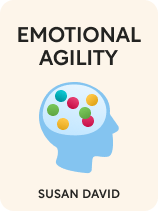

This article is an excerpt from the Shortform book guide to "Emotional Agility" by Susan David. Shortform has the world's best summaries and analyses of books you should be reading.
Like this article? Sign up for a free trial here.
Do you want to change but don’t know where to start? Does it seem overwhelming to you?
Susan David says that emotional agility includes living by true values rather than false narratives. To shift in that direction, she recommends making tiny tweaks. This means making successful, gradual changes regarding your belief in your abilities, your attitude toward change, and your routines.
Continue reading to learn about the tiny tweaks principle and how it can work for you.
Growth Through Tiny Tweaks
David writes that shifting from living by your narratives to living by your values entails making tiny tweaks—small, deliberate choices every day that serve your values.
Studies show that setting small goals for change is more likely to result in success than committing to huge, life-changing goals all at once. When your goals are smaller, the stakes for failure are lower. David says that, because you won’t be held back by emotions that often accompany failure, like fear of shame or embarrassment, you’ll be more likely to succeed.
(Shortform note: You don’t have to abandon long-term goals in lieu of setting smaller ones. Instead, consider breaking down large goals into smaller goals—giving you the benefits of smaller goals while still letting you work toward a larger one. In The 12 Week Year, Brian P. Moran and Michael Lennington offer advice for how to do this efficiently, suggesting that you set specific metrics and deadlines for your smaller goals. This helps you track your progress and see where you need to make adjustments if you want to ultimately succeed at your larger goal.)
David emphasizes three avenues for tiny tweaks that add up to successful, gradual change. Let’s explore each in detail.
Avenue 1: Your Belief in Your Abilities
To escape controlling narratives of fear and helplessness, David urges you to choose to believe that you’re capable of change and growth. Studies show that you’re more likely to succeed in your goals for change when you believe that capacity is within your power.
However, David doesn’t advise simply believing you will succeed at every goal regardless of its scope or the obstacles that stand in your way. Instead, she suggests approaching low-stakes goals with the belief that you will succeed. Over time, you’ll build a new narrative that you’re truly capable of success.
(Shortform note: While researchers agree that believing in your ability to succeed is an important foundation for achieving goals, it’s important to avoid overconfidence, especially when you lack the skills to approach a certain problem. This can lead you to make dangerous mistakes, like trying to wire your own home despite knowing little about electrical safety. Psychologists note the common mental bias of the Dunning-Kruger effect, the tendency for people to overestimate their knowledge or expertise in an area. To avoid the Dunning-Kruger effect, ask yourself how your assumptions might be flawed, and ask people with expertise in the area of your intended goal for feedback and critique.)
Avenue 2: Your Attitude Toward Change
The work of pursuing your goals—spending hours job hunting, for example—can feel like an unpleasant chore. This can make you less likely to follow through with your goals in the long term. To combat this frustration, reframe your responsibilities and tasks as things you genuinely want to do—and as stepping stones toward goals that you also want to achieve.
David says you’re more likely to feel motivated and committed in the long term when you approach tasks in this way.
(Shortform note: Researchers agree that reframing responsibilities to emphasize that you want to take them on is a powerful way to keep motivated. However, you should be careful when reframing—you don’t want to fall into a new controlling narrative by ignoring the negative elements of your situation or telling yourself that you have to stay positive. After all, your responsibilities won’t always be free of negative emotions, and an objective view of your situation will include the bad along with the good.)
Avenue 3: Your Routines
In addition to prompting your emotional reactions to narratives, your body and brain also drive you toward instinctive actions requiring little to no conscious thought: routines. When you repeatedly make the same desired choice—perhaps choosing fruit over candy if your value is “healthy eating”—that choice gradually becomes an instinctive routine.
David offers two ways to sculpt your routines to promote a gradual change that will serve your values:
1) Adjust your environment. Change how easily you can access things that help or hurt your values. If you want to journal instead of looking at your phone first thing in the morning, keep your journal by your bedside and leave your phone on a charger at the other end of the house.
2) Adjust an existing routine. It’s easier to change an existing routine than to create a new one, so a fairly simple way to add your values into your life is resolving to do a values-supporting behavior at the same time as a step in your routine. For example, if you want to show your partner you love her, you can add “write a caring note” to your current routine of preparing coffee.
David adds that if you habitually struggle with certain negative emotions, you can add the extra step of coming up with a positive response to your emotion. For example, if you frequently feel exasperated at your child’s behavior, you can tell yourself, “When I feel frustrated, I’ll stop, decide how I want to respond, and then answer.”
David warns you to stay aware and critical of your routines—even the new ones that serve your values. Falling too deeply into any routine puts you at risk of falling back into mindless behavior and automatic reactions.
(Shortform note: It can be difficult to remain mindful of your routines and whether they continue to serve your values over time. One way to do so is by conducting a regular audit of your routines—asking yourself questions that reveal whether they continue to support your values: Does this routine still serve a purpose, or is it just a habit? Do you care more about following the steps of the routine than about its original purpose? Does a change of plans that interrupts your routine put you in a bad mood? Does your routine feel boring? If you answer “yes” to any of these questions, take a closer look at that routine’s place in your life.)
| How Habits Work Understanding how routines and habits work can help you adjust them when necessary. In The Power of Habit, Charles Duhigg describes three essential elements of how a habit works: Cue: This is a trigger that signals the starting point of your habit and tells your brain to move into automatic mode to execute a specific routine. For example, you see a cookie and feel the urge to eat it. Routine: You act out the physical, mental, or emotional sequence of behavior that your brain has stored. For example, you pick up the cookie and eat it. Reward: This is the result of your routine and signals the end of your habit. For example, you feel a sugar rush from eating the cookie. You can deliberately add rewards to habits (like taking a short walk outdoors or eating a small piece of candy) to engineer the reward phase of a habit you’re trying to build. This principle also applies when adjusting an existing routine. If you’re trying to cut down on a habit of eating cookies, you might try drinking a cup of tea instead—and perhaps drinking it with less sugar over time. |

———End of Preview———
Like what you just read? Read the rest of the world's best book summary and analysis of Susan David's "Emotional Agility" at Shortform.
Here's what you'll find in our full Emotional Agility summary:
- Why most people react instinctively rather than objectively
- How to live according to your values to create the life you want
- How to handle your emotions better using mindfulness techniques






